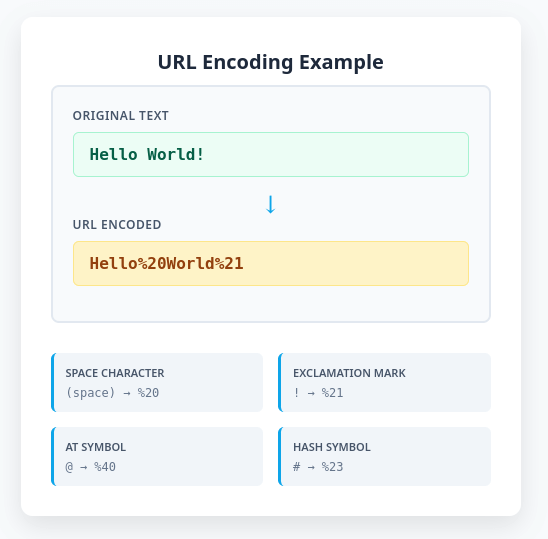URL Encoder & Decoder Tool
Easily encode text for safe URL transmission or decode URL-encoded strings back to readable text. URL encoding (percent encoding) ensures special characters are properly handled in web URLs, form submissions, and API requests.
Operation Mode
Encoding Options
Input Text
URL Encoded Result
Enter text to see URL encoding
Statistics
Quick Examples
About URL Encoding
URL encoding converts characters into a format that can be safely transmitted in URLs and form data.
Common Uses:
- • URL parameters
- • Form data submission
- • Search queries
- • API requests
Examples:
- • Space → %20
- • @ → %40
- • # → %23
- • % → %25
What is URL Encoding?
URL encoding (also called percent encoding) is a mechanism for encoding information in URLs where certain characters have special meanings or are not allowed. It converts characters into a format that can be safely transmitted over the internet.
Key characteristics of URL encoding:
- Percent notation: Uses % followed by hex codes
- Safe characters: A-Z, a-z, 0-9, -, ., _, ~
- Reserved characters: Have special meaning in URLs
- Universal compatibility: Works across all web systems
Example: "Hello World!" becomes "Hello%20World%21"

Features of Our URL Encoder Tool:
- Real-time conversion - Instant encoding/decoding as you type
- Flexible encoding modes - Standard or comprehensive character encoding
- Form data support - Handles + to space conversion for form submissions
- Unicode compatibility - Properly encodes international characters
- Error detection - Identifies invalid URL-encoded strings
- Statistics display - Shows encoding metrics and character counts
- Safe processing - All operations performed in your browser
- Copy functionality - Easy copying of encoded/decoded results
How to Use the URL Encoder Tool
1. Choose Operation Mode
Select "Encode for URL" to convert plain text to URL-safe format, or "Decode from URL" to convert URL-encoded text back to readable format.
2. Set Encoding Options
For encoding, choose between standard encoding (only necessary characters) or comprehensive encoding (all special characters) based on your needs.
3. Enter Your Data
Type or paste your text in the input field. The conversion happens automatically in real-time.
4. Copy Results
Use the copy button to copy the converted text to your clipboard for use in URLs, forms, or API requests.
URL Encoding Examples
| Original Text | URL Encoded | Use Case |
|---|---|---|
| Hello World! | Hello%20World%21 | Search query |
| [email protected] | user%40example.com | Email parameter |
| 50% discount | 50%25%20discount | Promotional text |
| C++ programming | C%2B%2B%20programming | Technical term |
Common Uses for URL Encoding
URL encoding is essential in various web development scenarios:
- Query parameters - Encoding values in URL query strings
- Form submissions - HTML form data transmission
- API requests - Sending parameters to REST APIs
- Search engines - Search query parameters
- Social media - Sharing URLs with special characters
- Email links - mailto: URLs with subjects/bodies
- JavaScript - AJAX requests with dynamic data
- Database queries - URL-based database filters
Character Encoding Reference
Common characters and their URL-encoded equivalents:
Reserved Characters
More Special Characters
Standard vs. Comprehensive Encoding
Standard Encoding
Encodes only characters that are not safe for URLs according to RFC standards.
Comprehensive Encoding
Encodes all non-alphanumeric characters for maximum compatibility.
Related Encoding Tools
Explore these related encoding and decoding tools:
Base64 Encoder/Decoder
Encode and decode text using Base64 encoding for data transmission and storage.
Try our Base64 Encoder tool →HTML Entity Encoder
Convert special characters to HTML entities for safe display in web pages.
Try our HTML Encoder tool →Frequently Asked Questions
When should I use URL encoding?
Use URL encoding whenever you need to include special characters, spaces, or non-ASCII characters in URLs, query parameters, or form data submissions.
What's the difference between + and %20 for spaces?
Both represent spaces, but %20 is the standard URL encoding while + is commonly used in form data (application/x-www-form-urlencoded). Our tool handles both formats.
Can I encode entire URLs?
You should only encode the parameter values, not the entire URL structure. Encoding protocol, domain, or path separators will break the URL.
Does URL encoding support Unicode characters?
Yes, our tool properly handles Unicode characters by first converting them to UTF-8 bytes, then applying percent encoding to each byte.
Why do I get an error when decoding?
Decoding errors occur when the input contains invalid percent encoding (like %GG) or incomplete sequences. Check your input format.
Technical Implementation
Our URL encoder uses JavaScript's built-in encoding functions with enhanced Unicode support:
This approach ensures:
- Proper UTF-8 character encoding
- Standards-compliant percent encoding
- Flexible encoding modes for different use cases
- Cross-browser compatibility